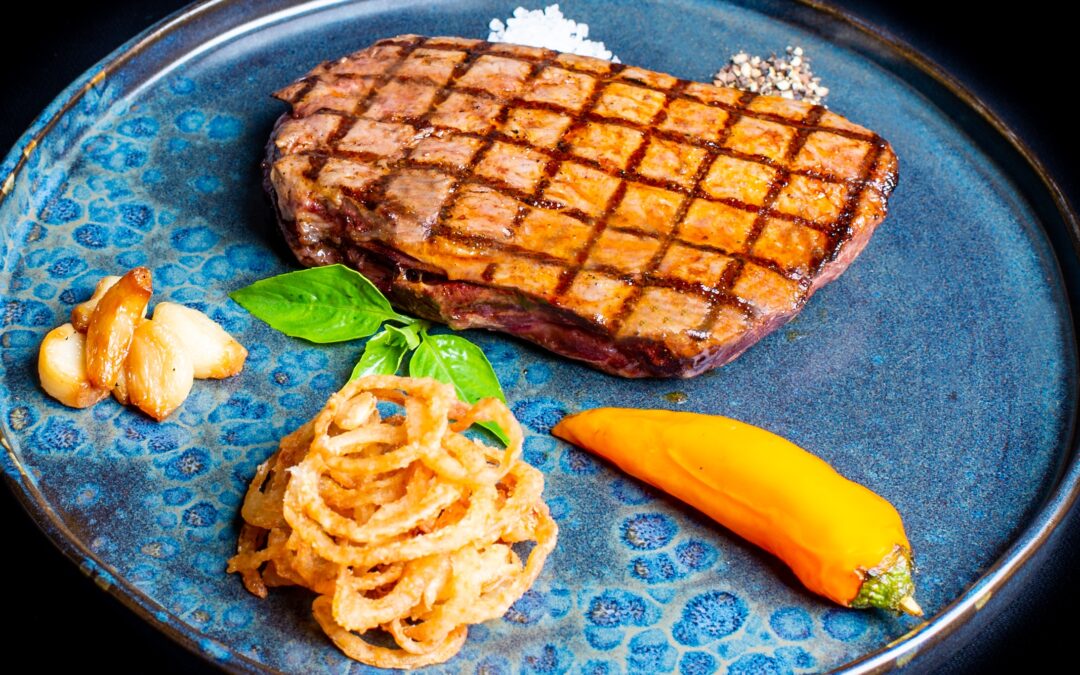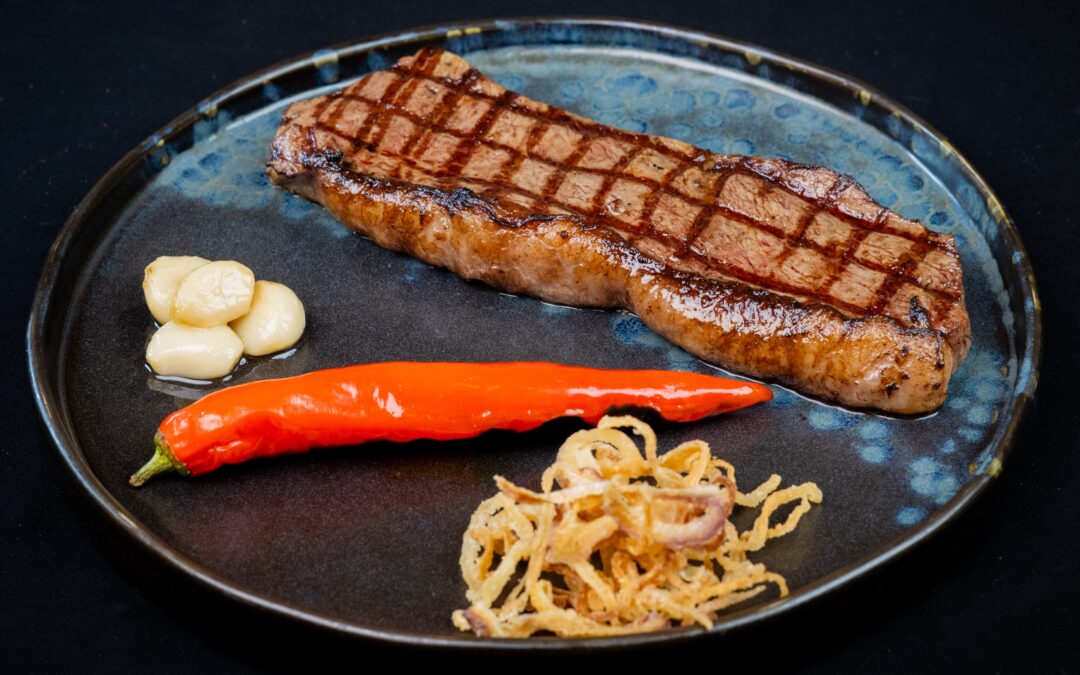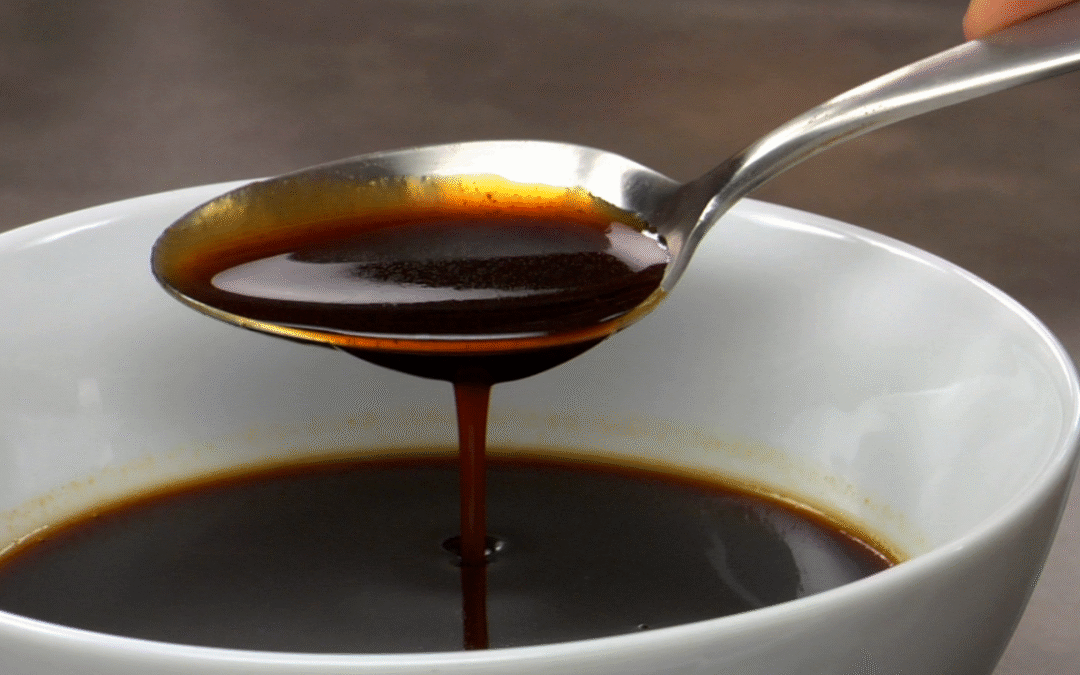
by Ross Kingsley | Feb 23, 2025 | KNOWLEDGE: MEAT ESSENTIALS
Wagyu beef stands out among premium cuts of meat, largely due to its unique Umami flavor. Umami, often described as a savory or “meaty” taste, is best described one of the five basic tastes alongside sweet, sour, salty, and bitter. This savory depth is a result of specific factors tied to the genetics and rearing of Wagyu cattle, creating a distinct dining experience.
Why Wagyu Has Exceptional Umami
The rich Umami in Wagyu comes from its high levels of marbling, or intramuscular fat, which is rich in oleic acid. This compound not only contributes to the beef’s tender texture but also enhances its savory flavor. Additionally, Wagyu contains elevated levels of naturally occurring glutamates, the compounds responsible for Umami. Combined with the meticulous care taken in raising the cattle, such as specialized diets and stress-free, low movement conditions, these factors contribute to the meat’s distinct flavor profile.
How Umami Affects the Palate
When cooked, Wagyu’s marbling melts into the meat, creating a buttery texture and amplifying the Umami taste. This savory richness activates multiple taste receptors, creating a layered and satisfying flavor experience. Unlike many cuts of beef, Wagyu doesn’t rely on heavy seasoning or sauces to stand out; its natural Umami is the defining characteristic.
Balanced & Memorable
Wagyu’s Umami doesn’t overwhelm the palate but instead offers a balanced of flavor. Its richness pairs well with minimal seasoning, such as salt, to let the natural qualities shine. For diners, this makes Wagyu a steak that feels indulgent, offering a memorable experience rooted in quality rather than extravagance.
Wagyu’s Umami isn’t just a feature of the beef; it’s an example of how careful breeding, diet, and preparation can elevate a meal.
Image Credit: https://churrascophuket.com/menus/ (Wagyu Solomillo, page 15)
_ _ _
© CHURRASCO PHUKET STEAKHOUSE / ALL RIGHTS RESERVED
>>> Reprinting, reposting & sharing allowed, in exchange for a backlink and credits <<<
Churrasco Phuket Steakhouse serves affordable Wagyu and Black Angus steaks and burgers. We are open daily from 12noon to 11pm at Jungceylon Shopping Center in Patong / Phuket.
We are family-friendly and offer free parking and Wi-Fi for guests. See our menus, reserve your table, find our location, and check all reviews here:
https://ChurrascoPhuket.com/
#Churrascophuket #jungceylon #phuketsteakhouse #affordablewagyu #wagyu

by Ross Kingsley | Feb 16, 2025 | KNOWLEDGE: MEAT ESSENTIALS
The Delmonico Steak is a historically significant dish, rooted in the early days of American fine dining. It originated at (and is named after) Delmonico’s, a celebrated New York City restaurant established in 1827, which became known for its emphasis on high-quality ingredients and sophisticated cuisine. The steak was a centerpiece of the restaurant’s menu, but its exact identity has sparked debate for over a century due to variations in how it was defined and served.
Originally, the term “Delmonico Steak” referred to a thick, high-quality cut of beef, and the best cut the butcher had to offer on that day. Early accounts suggest it was a boneless top loin cut, prized for its tenderness and marbling. However, the restaurant’s records did not specify a single cut, leading to widespread variation in its interpretation over time.
Today, the term can refer to a ribeye, bone-in rib steak, boneless New York strip, or even a chuck-eye steak, depending on the butcher or region. This lack of consistency has become part of the steak’s identity. However, what remains constant is its reputation as a premium dish synonymous with indulgence and quality.
Despite the ambiguity of its exact cut, the preparation of a Delmonico Steak has remained relatively straightforward. Traditionally, it is generously seasoned with salt and pepper, seared over high heat to form a caramelized crust, and finished with butter. It is often served with classic steakhouse sides like creamed spinach or potatoes.
In modern dining, the Delmonico Steak continues to be a popular choice at steakhouses and fine dining establishments. While its precise definition varies, its legacy as a symbol of American culinary heritage persists. The Delmonico Steak, whether served as a ribeye or another cut, represents a tradition of classic steakhouse fare.
Image Credit: https://wikipedia.org
_ _ _
© CHURRASCO PHUKET STEAKHOUSE / ALL RIGHTS RESERVED
>>> Reprinting, reposting & sharing allowed, in exchange for a backlink and credits <<<
Churrasco Phuket Steakhouse serves affordable Wagyu and Black Angus steaks and burgers. We are open daily from 12noon to 11pm at Jungceylon Shopping Center in Patong / Phuket.
We are family-friendly and offer free parking and Wi-Fi for guests. See our menus, reserve your table, find our location, and check all reviews here:
https://ChurrascoPhuket.com/
#Churrascophuket #jungceylon #phuketsteakhouse #affordablewagyu #wagyu

by Ross Kingsley | Feb 16, 2025 | KNOWLEDGE: MEAT ESSENTIALS
The striploin is a popular cut of beef, known for its balance of tenderness, flavour, and juiciness. It is carved from the short loin section of the cow, which lies between the rib and the sirloin. This muscle gets minimal exercise, resulting in a steak that is tender yet firm, with just the right amount of marbling to ensure a rich, beefy taste. When cooked properly, a striploin offers a delightful eating experience, making it a favourite among steak lovers worldwide.
The versatility of the striploin is one of its defining features. It can be cooked using a variety of methods, such as grilling, broiling, or pan-searing, and is often served with simple seasoning to let its natural flavour shine. Its consistent texture and size also make it a go-to choice for steakhouses and home cooks alike.
Interestingly, this cut goes by several names around the world, each reflecting local culinary traditions and terminology. In the United States, it is commonly referred to as the “New York Strip,” a nod to its popularity in New York City steakhouses. Australians and New Zealanders know it as the “Porterhouse” or “Sirloin Steak,” although in some contexts, these names can refer to slightly different cuts.
In the United Kingdom and Ireland, it’s called the “Sirloin Steak,” while in Canada, it’s often labelled as a “Striploin.” The French, renowned for their culinary precision, name it “Contre-Filet.” Meanwhile, in Brazil and other parts of South America, it forms part of the prized “Bife de Chorizo,” often featured in churrasco-style barbecues.
No matter what it’s called, the striploin steak remains a universal favourite, offering a consistent, flavourful, and satisfying dining experience across continents. Whether you’re savouring it at a high-end steakhouse or grilling it in your backyard, the striploin is a cut that delivers.
_ _ _
© CHURRASCO PHUKET STEAKHOUSE / ALL RIGHTS RESERVED
Reprinting, reposting & sharing allowed, in exchange for a backlink and credits
Churrasco Phuket Steakhouse serves affordable Wagyu and Black Angus steaks and burgers. We are open daily from 12noon to 11pm at Jungceylon Shopping Center in Patong / Phuket.
We are family-friendly and offer free parking and Wi-Fi for guests. See our menus, reserve your table, find our location, and check all guest reviews here:
Home
#Churrascophuket #jungceylon #phuketsteakhouse #affordablewagyu #wagyu

by Ross Kingsley | Feb 9, 2025 | KNOWLEDGE: MEAT ESSENTIALS
Demi-glace is a traditional meat-based French sauce known for its deep flavor and smooth texture. It is often used to enhance meats, stews, and other dishes. The name “demi-glace” means “half glaze,” referring to the process of reducing a stock and sauce into a thicker, more concentrated liquid.
Origins and History
Demi-glace has its roots in French cooking from the 17th and 18th centuries. Chefs like François Pierre La Varenne and later Auguste Escoffier developed and refined the techniques for making it. By the 19th century, demi-glace had become a key part of French cuisine, especially in fine dining.
Made With Meat
The sauce is made using a brown stock, typically prepared from roasted veal or beef bones, along with vegetables like carrots, onions, and celery. These ingredients are slowly simmered to extract flavor and gelatin, giving the sauce its rich taste and smooth texture. Traditionally, beef plays a pivotal role in the process, providing the foundation for the sauce’s signature flavor. This mixture is cooked and reduced until it reaches the right consistency. The process takes time and attention to detail, as the slow reduction allows the flavors to develop fully.
Uses and Variations
Demi-glace is used in many dishes. It can be served over steak or other meats, added to stews for extra flavor, or used as a base for other sauces like Bordelaise or Chasseur. Around the world, cooks have adapted it by using different stocks, such as chicken or fish, or even creating vegetarian versions for plant-based diets.
Why It’s Still Popular
Demi-glace continues to be an important part of cooking, valued for its ability to add flavor and texture to dishes. Whether made with traditional ingredients or adapted for modern diets, this sauce remains a versatile and practical tool in the kitchen. Its long history and adaptability ensure its place in cooking traditions today.
Image Credit: https://rouxbe.com/recipes/81-demi-glace-glace-de-viande
_ _ _
© CHURRASCO PHUKET STEAKHOUSE / ALL RIGHTS RESERVED
>>> Reprinting, reposting & sharing allowed, in exchange for a backlink and credits <<<
Churrasco Phuket Steakhouse serves affordable Wagyu and Black Angus steaks and burgers. We are open daily from 12noon to 11pm at Jungceylon Shopping Center in Patong / Phuket.
We are family-friendly and offer free parking and Wi-Fi for guests. See our menus, reserve your table, find our location, and check all reviews here:
https://ChurrascoPhuket.com/
#Churrascophuket #jungceylon #phuketsteakhouse #affordablewagyu #wagyu

by Ross Kingsley | Feb 9, 2025 | KNOWLEDGE: MEAT ESSENTIALS
Halal beef refers to meat from cattle that adheres to Islamic dietary laws, as prescribed by the Quran. The word “Halal” means “permissible” in Arabic, and it defines what Muslims are allowed to eat, ensuring that the food complies with both physical and spiritual cleanliness. Halal meat, including beef, is distinct because of the way the animal is treated and slaughtered.
For beef to be considered Halal, the animal must be healthy at the time of slaughter. It is crucial that a trained individual performs the slaughtering by invoking the name of Allah and using a sharp knife to swiftly complete the process. This process allows the blood to drain, as blood is considered impure in Islam. The focus on humane treatment and minimizing the animal’s suffering underscores the ethical considerations embedded in Halal practices.
The origins of Halal meat date back to the time of Prophet Muhammad in the 7th century. The dietary laws were established not only as a means of spiritual discipline but also for health reasons. The prohibition of certain foods, like pork or improperly slaughtered animals, and the emphasis on cleanliness reflected a comprehensive approach to hygiene and ethics.
Today, Halal beef is widely consumed by over 1.9 billion Muslims globally. It is not only a religious obligation but also a symbol of ethical farming and food production. As the demand for Halal products grows, many producers – like all suppliers to Churrasco Phuket Steakhouse – have adopted certification processes to ensure their products meet these strict standards. Halal beef is more than just meat—it’s a commitment to faith, ethical treatment of animals, and quality food production.
_ _ _
© Churrasco PHUKET STEAKHOUSE / ALL RIGHTS RESERVED
Churrasco Phuket Steakhouse serves affordable Wagyu and Black Angus steaks and burgers. We are open daily from 12noon to 11pm at Jungceylon Shopping Center in Patong / Phuket.
We are family-friendly and offer free parking and WiFi for guests. See our menus, reserve your table, find our location, and check all reviews here:
https://Churrascophuket.com/
#Churrascophuket #jungceylon #phuketsteakhouse #affordablewagyu #wagyu
Share
PreviousNext

by Ross Kingsley | Jan 19, 2025 | KNOWLEDGE: MEAT ESSENTIALS
Dry aging is a centuries-old technique used to enhance beef. The process involves storing large cuts of beef in a temperature- and humidity-controlled environment for several weeks, allowing “noble rot”, and for natural enzymes to break down muscle tissue to improve tenderness and intensifying the meat’s flavor.
Benefits of Dry Aging
The primary benefit of dry aging is “flavor development”. As the beef loses moisture over time, its flavors become more concentrated, resulting in a richer and nuttier taste that many connoisseurs describe as special. Additionally, the enzymatic breakdown of proteins enhances tenderness, creating a buttery texture. These qualities make dry-aged beef a luxurious choice for some steak lovers.
Risks and Dangers
Despite its benefits, dry aging comes with high risks. The process requires extremely precise control of temperature, constant humidity of 85%, and precise air circulation to prevent the growth of harmful bacteria and mold. Improper conditions lead to spoilage, food poisoning, and significant product loss. Moreover, as the beef dehydrates, it loses up to 30% of its weight, making it less cost-effective compared to other aging methods.
Dry Aging vs. Wet Aging
Dry aging is contrasted with wet aging, a more modern and cost-efficient method. Wet aging involves vacuum-sealing beef in plastic packaging, allowing it to tenderize in its own juices. Wet aging enhances tenderness and maintains weight. For restaurants and butchers, the choice between these methods often depends on their clientele’s preferences and willingness to pay a lot extra for a perceived “premium flavor”.
In Conclusion
Dry ageing is not a method employed at Churrasco Phuket Steakhouse. We instead focus on serving high-quality cuts of beef, always imported deep chilled, never frozen. The beef is then wet aged further in-house, and char-grilled to order when it is ready for use. Dry aging’s high cost, weight loss, and space requirements are considered counterproductive in a very busy steakhouse like Churrasco, which prioritizes consistency and accessibility for its diverse clientele.
By sourcing top-grade beef and preparing it with expert techniques, Churrasco Phuket delivers exceptional flavor and tenderness without the added complications of dry aging, ensuring every guest enjoys a world-class dining experience. Our excellent guest reviews on Google, Tripadvisor or Facebook are proof of the validity of our approach.
Image Credit:
https://en.wikipedia.org
_ _ _
© CHURRASCO PHUKET STEAKHOUSE / ALL RIGHTS RESERVED
>>> Reprinting, reposting & sharing allowed, in exchange for a backlink and credits <<<
Churrasco Phuket Steakhouse serves affordable Wagyu and Black Angus steaks and burgers. We are open daily from 12noon to 11pm at Jungceylon Shopping Center in Patong / Phuket.
We are family-friendly and offer free parking and Wi-Fi for guests. See our menus, reserve your table, find our location, and check all reviews here:
https://ChurrascoPhuket.com/
#Churrascophuket #jungceylon #phuketsteakhouse #affordablewagyu #wagyu






